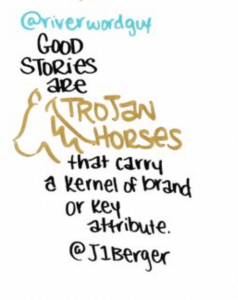
One Company. Many Stakeholders. How Many Messages?
One thing companies need but don’t always have is a single source of truth.
Marketing becomes far more effective when there’s one main story about your company that rings true for all audiences – customers, employees, investors, influencers, and even regulators.
Without such a message, your company’s communications become unfocused. They may begin to sound like the Tower of Babel, as each department speaks its own language to its own narrow audience.
Without an overall message, nothing in the center holds your story together.
There’s no shared language, purpose, or guidance.

To create a company message that’s the single source of truth, start with your top-level “umbrella” message. Your umbrella message is crucial because it alone addresses and balances the interests of all your various stakeholders.
Create your umbrella message first, and you’ll head off the inevitable conflicts that arise when companies try to address the needs of each stakeholder with a separate message. These days, employees are often customers or shareholders, or both.
Your umbrella message needs to be one that can be broadcast to all stakeholders, rather than narrowcast to only one group at a time.
When you create an umbrella message, you avoid problems like these:
- Some companies brag to shareholders about raising prices and improving profitability while downplaying the price increases to customers. But customers always figure it out.
- If you plan to cut costs, be sure to tell the same story about the changes to your investors, customers, and employees. They’re going to compare notes.
- Make sure the story you share with customers, employees, and investors jibes with the story you tell outsiders such as regulators, the news media, and industry analysts. Otherwise, regulators will punish you.

A great umbrella message often reflects your company’s purpose – why it exists.
What exactly does your company do that makes the world a better place for customers, investors, and employees? How does it help them succeed in accomplishing their goals?
A great umbrella message also reflects the consciousness of the risks that each stakeholder is taking. Not all risks are created equal.
Your customers are risking their hard-earned money.
On a large carefully considered purchase, they may be risking their finances or career too. That’s why your story needs to stay consistent whether customers hear it from sales, marketing, customer service, or other customers on the Internet.
Make sure your customer message consistently infuses all customer touchpoints. It’s crucial that the behaviors and messages are aligned.
One of the most disappointing experiences for customers is to get a promise from sales and then find out later that customer service just can’t fulfill it. Such behavior erodes the value of your brand and eventually costs you customers.
Employees are risking their livelihoods, careers, and reputations.
And today’s employees are always talking to their past and prospective employees.
If you need to recruit the best future employees, your message needs to address the needs of past, present, and future employees. Make sure your employee promise is simple, clear, and kept.
Remember, employees believe each other more readily than they believe any executive, spokesperson, or company. If there’s something great about your company, encourage your employees to tell others on social media and sites like Glassdoor.
One of the worst experiences is for a new employee to hear nothing but negatives through the employee grapevine. Negative talk may spring from bad management behaviors (e.g., Fox News), soured employees, simple neglect, or many separate fiefdoms vying for attention.
Don’t let employee orientation become the first stop on the way to employee disillusionment.
When I started one new job, an HR orientation leader asked us new recruits this question:
Why do people join this company?”
His question was met with silence.
Then he said, “Look around the parking lot at all those Jaguars and BMWs. You join this company, you get rich.”
What’s the problem with that message?
It promotes a culture of greed, not teamwork, by placing the interests of employees ahead of customers, investors, and everyone else. And it fails to encourage a culture that shows new employees how to treat customers and fellow employees. It reflects the absence of an umbrella message.
Investors seek a message that reflects a sound strategy for growth, a strong leadership team, and consistent performance over time.
Too many companies just rattle off the numbers that were already disclosed in an earnings release. They fail to provide color about progress on the company strategy, specific actions to strengthen the leadership team, and a consistent track record of performance.
I’ll never forget sitting in a conference room with a CEO and his top advisers when he asked,
What happened? We announced earnings that were up and a forecast that’s positive. Why did our shares go down?”
I was alone in venturing to answer his question. “Because we’ve lost credibility with investors,” I said. The clock slowed down as the silence in the room grew deafening.
Then the CEO responded, “I don’t want to hear that.” Did anyone else speak up? Of course not.
It’s hard to speak truth to power, especially when power makes it abundantly clear it doesn’t seek to hear the truth.
Yet truth must be the starting point for any message if it’s going to be believed by your stakeholders. If your company can’t face facts, your message is doomed to fail.
Influencers put their reputations at risk.
Don’t forget about the power of influencers to build your reputation with customers, employees, and investors by giving you third-party support.
Listen to and engage in a dialogue with key influencers, because:
- What the news media says will be heard by all of your audiences.
- What industry and financial analysts say will be sought out.
- What bloggers and social media users say will spread.
- What your local community says must be listened to; don’t risk future community relations problems by being deaf to the community.
- What activists say points to the company’s future vulnerabilities.
With the right umbrella message, you can address all your key stakeholders with a positive story that shows what’s in it for them (WIIFM).
With your umbrella message in hand, you’ve built a unifying platform for all the company’s messaging. Next, you can build coherent messages for your separate audiences, business units, geographies, and products – all of which connect back to your main umbrella message.
Use a 1-Page Message Map to build your umbrella message and keep your company’s story consistent, compelling and coherent.
Related Posts
How Does A B2B Company Start Content Marketing?
Start where you are. Adopt the right mindset: See the world through the eyes of buyers. Each company has different assets and strengths that...
52 Insights to Spark New Marketing Ideas
Fresh Ideas on Storytelling, Disruption, Messaging, Customers, Content & Analytics Business Marketing Association (BMA) conferences convened hundreds of B2B marketers and marketing thought leaders....
Customers Tune Out So Quickly, What Can Content Marketers Do?
Content marketers are in a war to win customers’ attention. Are you prepared to win? Thanks to content overload, more and more content marketing...
Will we see a digital marketing backlash?
Remember when digital marketing was the future? Marketers scrambled to persuade their organizations to put more money into digital and less into print. Everything...





